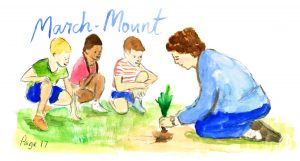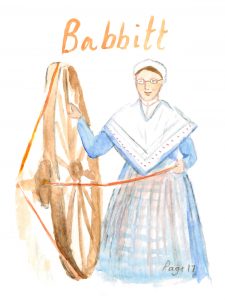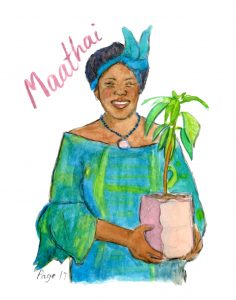Celebrating Female Foresters!

Written and illustrated by Page Biersdorff
International Women’s Day is a time to celebrate the achievements and contributions of women to drive positive change and affirm our collective commitment to equality and equity. Pacific Northwest forests have been shaped by the incredible women who have dedicated themselves to protecting our woodlands and improving the forestry profession. Here are just a few of the female leaders who have fought for the forests we depend on:
Tabitha Babbitt
Every circular saw we use today is owed to a Shaker weaver by the name of Tabitha Babbitt. Observing men working logs with pit saws, she was struck by the waste of energy required. A pit saw only cuts on alternating strokes, wasting half the strokes. In 1810, she attached a circular blade to her spinning wheel, cutting the required labor in half. Three years later, a larger version of the circular saw was used to cut lumber at a local saw mill. The acceptance of female leadership in Shaker society may have enabled Babbitt to be a pioneer in a time when women were second-class. Learn more about Tabitha Babbitt.
Maria Sanford & Florence Bramhill
These two women tirelessly fought to achieve the protection of 400,000 acres of forestland that would later become the Chippewa National Forest. Maria Sanford, one of the first female professors in the United States and leader of the Minnesota Federation of Women’s Clubs, along with Florence Bramhill, head of the Federation’s Forest Reserve Committee, fought a new law that would allow large-scale timber harvest in federally-owned Minnesota forests. Thanks to the women’s pioneering efforts, congress was convinced of the forestland’s value. The Federation also promoted active forest management and limited logging. Since the preserve’s protection in 1902, the reserve has more than tripled in size and includes 1,300 lakes and almost 1,000 miles of streams. These early conservationists encouraged President Roosevelt to set aside Forest reserves and led to the establishment Department of Agriculture and Forest Service not long after. Learn more about Maria Sanford and Florence Bramhill.
Margaret Stoughton Abell
The first female Forest Service Research Forester, Margaret Stoughton Abell broke a significant glass ceiling and paved the way for other women to enter the male-dominated field of forestry and forest science. After graduating from Iowa State College in 1930 with a Bachelor’s degree in forestry, Stoughton Abell courageously applied for a research position entirely dominated by men. The Appalachian Forest Experiment took the young forester on, making her the first woman Forest Service Researcher. Her numerous field photos over her seven years with the Forest Service reveal her talent, passion and love for natural beauty. Learn more about Margaret Stoughton Abell.
Margaret March-Mount
 After humble beginnings as a Wyoming clerk, Margaret March-Mount became a famous conservation educator with Forest Service. Her dedication to a healthier future, demonstrated through passionate writing and speaking about the benefits of planting trees, led to her promotion to “assistant information specialist,” though March-Mount’s preferred title was “ambassador of the trees.” In this role, she addressed the public about the crucial need for healthy forests. During her “Pennies for Pines” Children’s Conservation Crusade in the 1930s, children donated pennies to fund tree plantings on National Forest land. By 1940, the program had funded the planting of 6 million trees on 6,000 acres. Learn more about Margaret March-Mount.
After humble beginnings as a Wyoming clerk, Margaret March-Mount became a famous conservation educator with Forest Service. Her dedication to a healthier future, demonstrated through passionate writing and speaking about the benefits of planting trees, led to her promotion to “assistant information specialist,” though March-Mount’s preferred title was “ambassador of the trees.” In this role, she addressed the public about the crucial need for healthy forests. During her “Pennies for Pines” Children’s Conservation Crusade in the 1930s, children donated pennies to fund tree plantings on National Forest land. By 1940, the program had funded the planting of 6 million trees on 6,000 acres. Learn more about Margaret March-Mount.
Wangari Maathai
In the 1970s, Wangari Maathai changed the world. The first woman in East and Central Africa to earn a doctorate degree, Maathai established the grassroots organization, the Green Belt Movement, in an effort to reforest land and empower women. Since then, 51 million trees have been planted and thousands of women have been trained in forestry and other related fields. The Green Belt Movement model of activism through direct community empowerment has been replicated all over the world with great success. Maathai became the first African woman to receive the Nobel Peace Prize in 2004. Learn more about Wangari Maathai.
Francesca Cafferata Coe
The Society of American Foresters awarded Oregon’s own Francesca Cafferata Coe with the 2016 Young Forester Leadership Award. The annual award celebrates outstanding leadership by young foresters. Hailing from Hilsboro, Cafferata Coe studied Fisheries and Wildlife Science at Oregon State University. Understanding the inherent relationship between forest and wildlife, she owns a natural resource consulting firm while providing leadership within the SAF and The Wildlife Society. Learn more about Francesca Cafferata Coe.
Amy Grotta
Oregon State University is lucky to have Amy Grotta around. She wears many hats, as an associate professor of Agricultural Sciences and as an extension agent in the Forest and Natural Resources Program. With expertise in small woodlands management and silviculture, Grotta educates small woodland owners around the state. Read Amy Grotta’s blog.
Lindsay Malone
Our very own Lindsay Malone joined us in 2012 and is now the Member Services Director. She has 15 years of experience working on natural resource and conservation issues for local, state and federal agencies and non-profit organizations, and specializes in working with owners of small forests to steward their land and achieve their goals. Prior to NNRG, Lindsay worked at Forterra where she contributed to the conservation of more than 10,000 acres of working forests, natural areas and recreation lands. Upon completion of her master’s degree at the University of Washington’s College of Forest Resources, she conducted a study to identify the needs and interests of first-time forest owners. Learn more about Lindsay Malone.



Leave a Reply